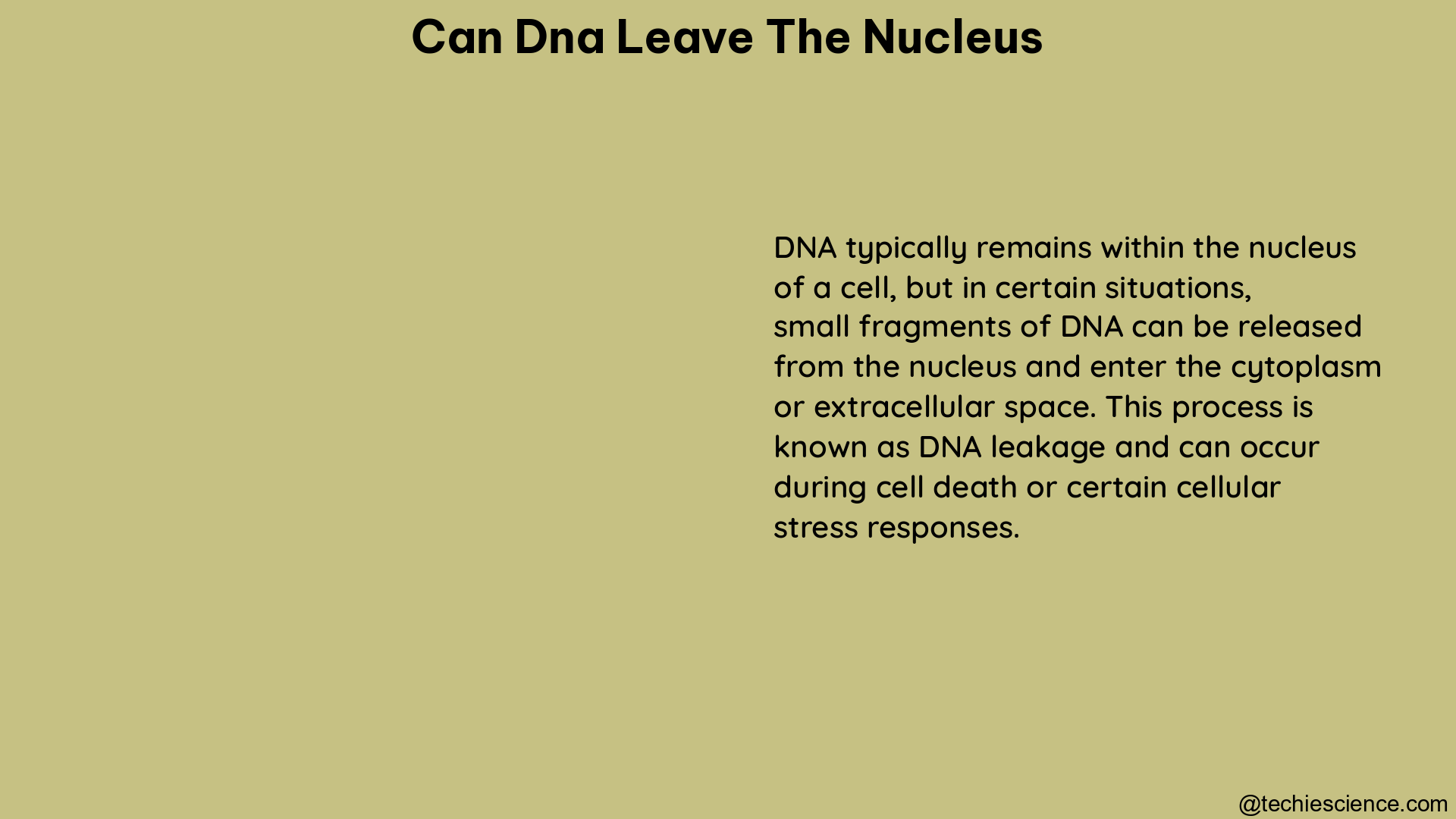DNA, the fundamental genetic material that carries the instructions for life, is typically confined within the nucleus of eukaryotic cells. This strict compartmentalization is essential for the proper functioning and regulation of cellular processes. In this comprehensive guide, we will delve into the intricate details of DNA’s relationship with the nucleus, exploring the reasons why it does not leave this vital organelle and the critical implications of this confinement.
The Importance of Nuclear Confinement
The nucleus serves as the command center of the eukaryotic cell, housing the genetic material and orchestrating the intricate dance of gene expression and protein synthesis. This strict compartmentalization of DNA within the nucleus provides several key benefits:
-
Protection from Cytoplasmic Threats: The cytoplasm, the fluid-filled region surrounding the nucleus, can be a hostile environment for DNA. It contains various enzymes, free radicals, and other potentially harmful elements that could damage or alter the genetic material. By keeping DNA within the confines of the nucleus, the cell ensures its genetic integrity is maintained.
-
Regulation of Gene Expression: The nuclear membrane acts as a barrier, controlling the flow of information and molecules between the nucleus and the cytoplasm. This allows the cell to precisely regulate gene expression, ensuring that the right genes are turned on or off at the appropriate times, enabling the cell to respond to changing environmental conditions and developmental cues.
-
Efficient Transcription and Translation: The separation of DNA and the protein synthesis machinery (ribosomes) in the cytoplasm facilitates the efficient transfer of genetic information through the process of transcription and translation. This spatial organization optimizes the flow of information and the production of necessary proteins.
The Structural Barriers Preventing DNA Exodus

The confinement of DNA within the nucleus is not merely a passive phenomenon; it is actively maintained by the physical and structural characteristics of the nuclear envelope and its associated components.
-
Nuclear Pore Complexes: The nuclear envelope is perforated by nuclear pore complexes, which serve as the sole conduits for the exchange of molecules between the nucleus and the cytoplasm. These pore complexes are highly selective, allowing the passage of small molecules and proteins while restricting the movement of larger structures, such as DNA.
-
The nuclear pore complexes have a diameter of approximately 120 nanometers (nm), which is significantly smaller than the size of a DNA molecule, which can range from hundreds to billions of base pairs, each measuring around 0.34 nm in length.
-
The nuclear pore complexes are equipped with a series of intricate mechanisms, including transport proteins and gating systems, that precisely control the movement of molecules in and out of the nucleus.
-
Nuclear Lamina: The nuclear lamina is a dense network of proteins that lines the inner surface of the nuclear envelope. This structural framework provides mechanical support and helps maintain the shape and integrity of the nucleus.
-
The nuclear lamina is composed of lamin proteins, which form a mesh-like structure that reinforces the nuclear envelope and contributes to the overall rigidity of the nucleus.
-
The nuclear lamina also interacts with chromatin (the complex of DNA and associated proteins) within the nucleus, further anchoring the genetic material in place and preventing its escape.
-
Chromatin Organization: The DNA within the nucleus is not simply a loose, unorganized molecule. It is tightly packaged and organized into a complex structure known as chromatin, which further restricts its mobility.
-
Chromatin is formed by the wrapping of DNA around histone proteins, creating a compact and highly structured arrangement.
- This chromatin organization, along with the interactions between the DNA and various nuclear proteins, effectively traps the genetic material within the confines of the nucleus.
The Relay of Genetic Information
While DNA itself does not leave the nucleus, the cell has developed a sophisticated mechanism to transmit the genetic information to the cytoplasm, where protein synthesis occurs. This process is known as transcription and involves the following steps:
-
Transcription: The enzyme RNA polymerase transcribes the genetic information from the DNA template within the nucleus, generating a single-stranded RNA molecule called messenger RNA (mRNA).
-
mRNA carries the genetic instructions for the synthesis of specific proteins, acting as a bridge between the DNA in the nucleus and the protein synthesis machinery in the cytoplasm.
-
The mRNA molecules are then transported through the nuclear pore complexes into the cytoplasm, where they are recognized and utilized by the ribosomes for protein synthesis.
-
Translation: In the cytoplasm, the mRNA molecules are read by the ribosomes, which translate the genetic information into the corresponding amino acid sequence, ultimately leading to the production of the desired proteins.
-
The regulation of protein levels is primarily dictated by the translation of mRNAs into proteins within the cytoplasmic ribosomes, highlighting the critical role of the cytoplasm in orchestrating cellular functions.
This strict compartmentalization of DNA within the nucleus, coupled with the relay of genetic information through mRNA, ensures the proper regulation of gene expression and the efficient production of proteins necessary for various cellular processes.
Exceptions and Special Circumstances
While the general principle of DNA confinement within the nucleus holds true for the majority of eukaryotic cells, there are a few exceptions and special circumstances where DNA may temporarily or partially leave the nucleus:
-
Mitochondrial and Chloroplast DNA: In eukaryotic cells, mitochondria and chloroplasts (in plant cells) contain their own small, circular DNA molecules. These organellar DNA molecules are not housed within the nucleus but rather reside in the cytoplasm, where they are responsible for the expression of genes related to the organelle’s function.
-
Viral Infection: During the replication cycle of certain viruses, the viral genetic material may be temporarily transported out of the nucleus and into the cytoplasm, where it can be replicated and packaged into new viral particles.
-
Nuclear Export of RNA: While DNA itself does not leave the nucleus, various types of RNA molecules, such as mRNA, tRNA, and snRNA, are actively transported out of the nucleus through the nuclear pore complexes to perform their respective functions in the cytoplasm.
-
Nuclear Transfer Techniques: In certain biotechnological and research applications, such as cloning or nuclear reprogramming, the nucleus of a cell may be extracted and transferred to a different cellular environment, temporarily disrupting the normal confinement of DNA within the nucleus.
These exceptions, while noteworthy, do not undermine the general principle of DNA confinement within the nucleus, which remains a fundamental characteristic of eukaryotic cell biology and a crucial aspect of cellular organization and function.
Conclusion
In summary, the confinement of DNA within the nucleus of eukaryotic cells is a critical aspect of cellular organization and function. This strict compartmentalization serves to protect the genetic material from potentially harmful elements in the cytoplasm, while also enabling the precise regulation of gene expression and the efficient production of necessary proteins. The physical and structural barriers, such as the nuclear pore complexes, nuclear lamina, and chromatin organization, work together to maintain this essential compartmentalization. While there are a few exceptions and special circumstances where DNA may temporarily or partially leave the nucleus, the general principle of DNA confinement remains a fundamental characteristic of eukaryotic cell biology.
References:
- DNA and the Nucleus: Keeping Genetic Material Safe
- Protein Synthesis Review
- Measurements of the Amount of DNA per Nucleus
- The Nuclear Pore Complex: Understanding the Gateway to the Nucleus
- The Nuclear Lamina: Structure, Function, and Connections with the Genome
- Chromatin Organization and Gene Regulation

Hi….I am Shravanthi Vikram, I have completed my master’s in Bioinformatics and have 10 years of teaching experience in Biology.
Let’s connect through LinkedIn-